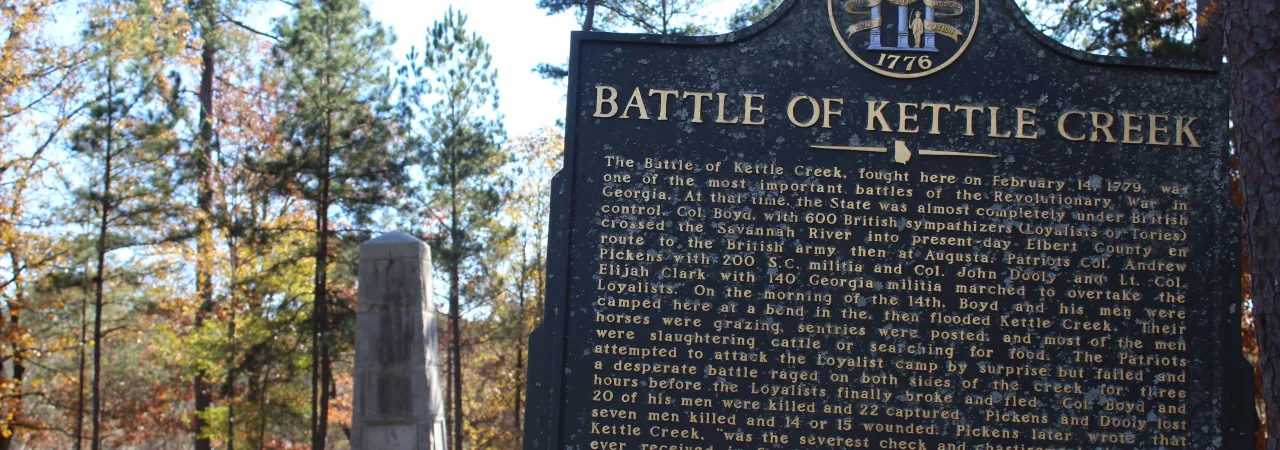
On War Hill, a Georgia state historic marker reveals to readers the story of the 1779 Revolutionary War battle that unfolded on this land.
With his men in tow, Loyalist Colonel John Boyd wandered through the Carolina backcountry with the goal of reaching the British army in Georgia. Yet, American Patriots like General and South Carolina plantation owner Andrew Williamson had other ideas in mind for this Loyalist force as he hoped to turn the tide in the backcountry in favor of the Whigs. American Colonel Andrew Pickens had been on the trail of Boyd’s men. On the morning of February 14th, 1779, Pickens and his backcountry Whig militiamen, fiercely ambushed Loyalist forces at Kettle Creek. While Boyd’s Loyalists greatly outnumbered the American militiamen, the element of surprise ultimately led to an American victory.
In the aftermath of battle, a number of Loyalists were taken prisoner.
In the Carolina backcountry there was an ongoing fear that residents would turn to the British cause. Before hearing the result of the attack at Kettle Creek, Williamson had already decided that [if victorious] Pickens’ prisoners would serve as a deterrent to future American defectors in the backcountry. Hoping to avert more Loyalists from picking up arms, Williamson wrote,
“Our eyes are now opened and not with standing the lenity hitherto shown them they have at this crisis given convincing proofs, and that no faith should or ought be placed in their most solumn assurance and a severe example must certainly be made for the benefit of the State, and as a terror to others.”
Williamson learned of the American victory at Kettle Creek by February 20th. He was pleased to hear that a handful of his Carolina neighbors would be turned into “severe examples.” While only twenty or so Loyalists were captured at Kettle Creek, the group of prisoners were treated more like cattle than men. Many of the prisoners were suffering from battle wounds. The group was marched to Augusta, Georgia in chains and put in the bullpen of Old Fort Augusta. They were later joined by 78 Kettle Creek Loyalists who had turned themselves over to Williamson on the false promise that they would be released and posted bond if they were to come to his camp. Other loyalists joined the Kettle Creek prisoners and soon the numbers swelled to more than 150 prisoners. The main distinction between the prisoners held at Augusta and other prisoners held during the war was that these men were not treated as prisoners of war, but instead as pure criminals. As criminals, these men were to be put on trial in the town of Ninety Six. Led by Colonel John Williams’ regiment, the prisoners were marched from Augusta, Georgia to Ninety Six, South Carolina with a brief stop at General Williamson’s bull pen. The prisoners arrived at the brick jail of Ninety Six by March 10th, 1779.
While South Carolina Governor John Rutledge ordered the trials to start on March 9th, they were postponed until March 22nd. Sheriff of Ninety Six, William Moore, was charged with the task of selecting members of the jury. While the court proceedings have been lost to time, we do know basic facts and figures surrounding the trials. Approximately 75 men were released. According to the Gazette of the State of South Carolina, another 50 men were given reprieves after being found guilty because…
“it appeared upon their trials, that most of them had been seduced and terrified into the fatal step, by Boyd, and a number of people who frequently came amongst them from North Carolina, under a variety of pretenses; and for want of proper information on the nature of our contest with Great Britain.”
And the remaining group of approximately 20 Loyalists were sentenced to death. The trials concluded on April 12th.
One Loyalist by the name of Zachariahs Gibbes described the treatment of these condemned prisoners as cruel, saying that the prisoners were forced to look at the holes that were to be their future graves as well as the gallows they were to be hanged from. While sentenced to die on April 19th, these Loyalists seemed to strike luck when a writ of habeas corpus from Governor Rutledge came on that very day to halt the hangings. The Loyalist prisoners on death row were then moved to Orangeburg, South Carolina, where they were kept in the town’s blockhouse.
All the while, the British were ablaze with frustration as they attempted to have the accused Loyalist prisoners released or exchanged as prisoners of war. Unsuccessful, some British officials penned threats to the Americans. British Colonel James Mark Prevost wrote directly to Williamson to emphasize the consequences that would befall the American Whigs if any harm was done to his majesties “faithful subjects..." Williamson retorted that the men being held prisoner had… “daringly taken up arms against, and wantonly plundered the honest and industrious inhabitants of this state [South Carolina], were properly secured and delivered up to the civil law.” General Moultrie and Major Thomas Pinckney also received fiery requests from British officials, but the Americans insisted that the prisoners were being held under the tenets of civil law. Prevost considered revenge by exacting punishment on his Whig prisoners, but was persuaded by the threat of American backlash against other British prisoners.
The British threat however loomed on the minds of Patriot authorities. In effect, South Carolina officials started to question the consequences of moving forward with the execution of the prisoners at Orangeburg. They pondered the safety of themselves, their families, and their property if they pushed the British to react. Thus, when British Lieutenant Colonel Prevost launched an invasion into South Carolina in April of 1779, all but 5 of the Loyalist prisoners were granted reprieves. The last of the 5 prisoners were returned to Ninety Six where they were to receive their fatal punishment.
Sheriff William Moore oversaw the hangings of Charles Draper, John Anderson, James Lindley, Samuel Clegg, and Aquilla Hall. It was said that these men had committed cruel unforgivable acts against their patriot counterparts.
The men at the forefront of the trials and executions, Sheriff Moore and General Williamson, paid the consequences they so feared and ended up in British hands as the Redcoats took control of South Carolina in 1780. Moore was actually held in the same jail in Ninety Six as the Loyalist prisoners had once been in 1779. Meanwhile, Williamson surrendered himself to the British and accepted parole. He claimed that he had been working with the British all along… giving him the debated title of “Arnold of the South.”
Related Battles
21
115





